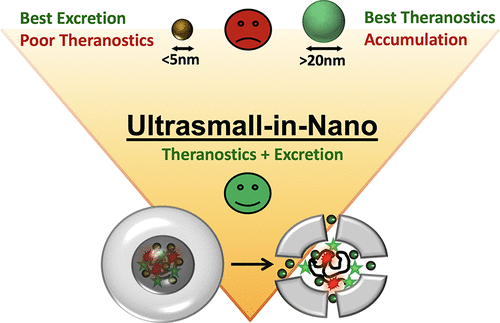当前位置:
X-MOL 学术
›
Bioconjugate Chem.
›
论文详情
Our official English website, www.x-mol.net, welcomes your feedback! (Note: you will need to create a separate account there.)
Ultrasmall-in-Nano Approach: Enabling the Translation of Metal Nanomaterials to Clinics
Bioconjugate Chemistry ( IF 4.7 ) Pub Date : 2017-11-29 00:00:00 , DOI: 10.1021/acs.bioconjchem.7b00664 Domenico Cassano 1, 2 , Salvador Pocoví-Martínez 3 , Valerio Voliani 1
Bioconjugate Chemistry ( IF 4.7 ) Pub Date : 2017-11-29 00:00:00 , DOI: 10.1021/acs.bioconjchem.7b00664 Domenico Cassano 1, 2 , Salvador Pocoví-Martínez 3 , Valerio Voliani 1
Affiliation

|
Currently, nanomaterials are of widespread use in daily commercial products. However, the most-promising and potentially impacting application is in the medical field. In particular, nanosized noble metals hold the promise of shifting the current medical paradigms for the detection and therapy of neoplasms thanks to the: (i) localized surface plasmon resonances (LSPRs), (ii) high electron density, and (iii) suitability for straightforward development of all-in-one nanoplatforms. Nonetheless, there is still no clinically approved noble metal nanomaterial for cancer therapy and diagnostics. The clinical translation of noble metal nanoparticles (NPs) is mainly prevented by the issue of persistence in organism after the medical action. Such persistence increases the likelihood of toxicity and the interference with common medical diagnoses. Size reduction to ultrasmall nanoparticles (USNPs) is a suitable approach to promoting metal excretion by the renal pathway. However, most of the functionalities of NPs are lost or severely altered in USNPs, jeopardizing clinical applications. A ground-breaking advance to jointly combine the appealing behaviors of NPs with metal excretion relies on the ultrasmall-in-nano approach for the design of all-in-one degradable nanoplatforms composed of USNPs. Such nanoarchitectures might lead to the delivery of a novel paradigm for nanotechnology, enabling the translation of noble metal nanomaterials to clinics to treat carcinomas in a less-invasive and more-efficient manner. This Review covers the recent progresses related to this exciting approach. The most-significant nanoarchitectures designed with the ultrasmall-in-nano approach are discussed, and perspectives on these nanoarchitectures are provided.
中文翻译:

纳米超小型方法:使金属纳米材料向诊所的翻译成为可能
当前,纳米材料广泛用于日常商业产品中。但是,最有前途且可能会产生影响的应用程序是在医学领域。尤其是,由于以下原因,纳米级贵金属有望改变当前用于检测和治疗肿瘤的医学范例:(i)局部表面等离振子共振(LSPR),(ii)高电子密度和(iii)适用于多合一纳米平台的直接开发。然而,仍然没有临床批准的用于癌症治疗和诊断的贵金属纳米材料。贵金属纳米颗粒(NPs)的临床翻译主要是通过医学作用后生物体内的持久性问题来防止的。这样的持久性增加了毒性的可能性以及对普通医学诊断的干扰。减小超小纳米颗粒(USNPs)的尺寸是一种通过肾脏途径促进金属排泄的合适方法。但是,大多数NP的功能在USNP中丢失或严重改变,从而危及临床应用。将NP的吸引人的行为与金属排泄物相结合的突破性进展,是依靠超小型纳米方法来设计由USNP组成的多合一可降解纳米平台。这样的纳米体系结构可能会导致提供一种新的纳米技术范式,从而使贵金属纳米材料向临床领域转化,从而以一种侵入性更小,更有效的方式治疗癌症。这篇综述涵盖了与此令人兴奋的方法相关的最新进展。讨论了用超小型纳米方法设计的最重要的纳米结构,
更新日期:2017-11-29
中文翻译:

纳米超小型方法:使金属纳米材料向诊所的翻译成为可能
当前,纳米材料广泛用于日常商业产品中。但是,最有前途且可能会产生影响的应用程序是在医学领域。尤其是,由于以下原因,纳米级贵金属有望改变当前用于检测和治疗肿瘤的医学范例:(i)局部表面等离振子共振(LSPR),(ii)高电子密度和(iii)适用于多合一纳米平台的直接开发。然而,仍然没有临床批准的用于癌症治疗和诊断的贵金属纳米材料。贵金属纳米颗粒(NPs)的临床翻译主要是通过医学作用后生物体内的持久性问题来防止的。这样的持久性增加了毒性的可能性以及对普通医学诊断的干扰。减小超小纳米颗粒(USNPs)的尺寸是一种通过肾脏途径促进金属排泄的合适方法。但是,大多数NP的功能在USNP中丢失或严重改变,从而危及临床应用。将NP的吸引人的行为与金属排泄物相结合的突破性进展,是依靠超小型纳米方法来设计由USNP组成的多合一可降解纳米平台。这样的纳米体系结构可能会导致提供一种新的纳米技术范式,从而使贵金属纳米材料向临床领域转化,从而以一种侵入性更小,更有效的方式治疗癌症。这篇综述涵盖了与此令人兴奋的方法相关的最新进展。讨论了用超小型纳米方法设计的最重要的纳米结构,



























 京公网安备 11010802027423号
京公网安备 11010802027423号